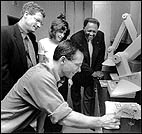![]()
![]()
![]()
![]()
![]()
![]()
State-of-the-Art
Hazardous Materials Facility Opens
By Julia Sommer,
Public Affairs
Posted April 21, 1999
|
|
|
Cutting the ribbon -- or in this case, the yellow caution tape -- were Patrick Goff, manager of the Hazardous Materials Management Team; Horace Mitchell, vice chancellor - business and administrative services; and Susan Spencer, director of Environment, Health & Safety, under whose aegis the $10 million facility falls.
Replacing the old and inadequate [Strawberry] Canyon Chemical Facility, HMF (yet another campus acronym) will be used primarily for processing and packaging campus chemical and radioactive waste that will then be sent off-site for treatment, storage and disposal.
The canyon facility will be turned into a UC Botanical Garden center for research and training in plant population biology.
At the HMF christening ceremony, Goff told of the arduous, 10-year journey from proposal to finished building. Among the hurdles: passionate neighborhood resistance to an enlarged Strawberry Canyon facility, university budget cuts and foul weather.
"Construction began with El Niño and ended with la Niña," said Goff.
In between, rose a two-story, 23,000-square-foot building structurally superior to any other on campus. Designed to maintain operations after "the worst credible earthquake," it boasts emergency back-up power, a 15,000-gallon underground tank, filtered ventilation and labs for analysis -- "all the bells and whistles," as Goff put it.
All operations will be performed indoors and chemical reuse areas will minimize waste.
At the opening ceremony, Mitchell announced that Spencer
is leaving for a year to serve on the UN Compensation
Commission in Geneva assessing environmental damage caused
by the Gulf War. In her absence, Mark Freiberg will be
acting director of EH&S.
![]()
![]()
April 21 - 27, 1999
(Volume 27, Number 31)
Copyright 1999, The Regents of the University of
California.
Produced and maintained by the Office
of Public Affairs
at UC
Berkeley.
Comments? E-mail berkeleyan@pa.urel.berkeley.edu.
